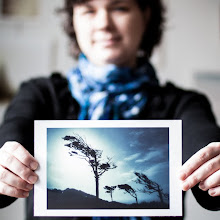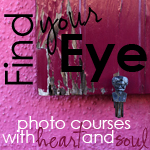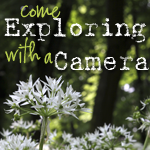With the change in seasons, in the places I've lived the last 12 years or so, we wave good-bye to the consistently sunny days and welcome the wet. Rain will be a consistent part of life for the next few months as winter comes on, with the occasional break in the monotony for snow or sun when we're lucky. A rainy day is a great time to curl up under a blanket, with a book and a cup of tea. It is also a great time to get out and photograph!
A while ago I wrote a blog post that said when life gives you rain, you should take photos anyway. Today let's explore the ways to capture the beauty to be found in the rain...
The light is completely different in the rain. First off, it's usually cloudy during the day, which provides softer, indirect light. Second, the wet surfaces reflect the light in completely different ways than dry surfaces. The photo at the top of the post is a good example of this - the leaf and the stones are highlighted by the reflections of the light. What would be an interesting composition for it's contrast when dry, gains even more interest for the way the individual elements stand out from the light on the water.
This photo from Orvieto, Italy is a daytime example of how the wet ground reflects the light, drawing your focus along the ground from the bright doorway in the top left down toward the scooter in the bottom right.
The wet ground in this photo of Bath, England at night serves to contrast and highlight the row of benches along the sidewalk. As I mentioned in my Exploring with a Camera post on Night Photography, wet surfaces at night can add much needed light for taking photos at night.
And while we're talking about puddles, how about capturing some splashing through them? Of course, this image is a bit more sedate than most puddle-splashing pictures, a capture of Italian rain fashion more than splashing but you get the idea. The movement of water in the puddle along with the reflections makes the photo more than just photo of rainboots.
Out in the rain, look for ways the water moves across and off surfaces. This restaurant table was so highly polished that the rain water beaded up into interesting shapes, a nice backdrop for the flowers.
Look for the drips ready to fall...
Look for the drops that grace the leaves.
It's also fun to capture people in the rain. They are more "anonymous" with their hoods and umbrellas, hunched up and hurrying along. I like to capture groups of colorful umbrellas, as on this bridge in Lucerne, Switzerland.
Or the lone traveller, trying to get someplace at night in Venice. People with umbrellas are quite the artistic staple, if you look at paintings through history.
Here we have quite a few different elements that I love in one rainy shot... umbrellas, multiple reflections, at night, and it's Venice. How could you go wrong?
There are so many ways I have yet to capture the rain, these are the images I'm still looking for:
- Looking out of a window covered in raindrops. Focus on the drops, with the scenery out of focus behind.
- Rain spilling out of our very cool dragon-shaped rainspout or off the edges of eaves.
- The rain in a downpour - I want to figure out how to capture the "look" of the world when you look through rain.
- Drops of rain splashing in puddles - oh those perfect, rippling circles just tantalize me!
So, how do you do shoot in the rain without ruining your camera? Here are a few tips:
1. Use an umbrella. If you have someone along with you, ask them to hold it over you and your camera when you shoot. If you don't have that option (or don't want to ask your companion to hold your umbrella every 15 seconds), a bigger umbrella works better than a small one for this "solo" technique: Rest the handle between your neck and shoulder with the umbrella resting on the top of your head. This will enable both hands to be free and your camera to be covered while you shoot. It does take some practice though, but try it out.
2. Find sheltering spots. Store awnings and overhangs, doorways, under trees, etc. can be great places to pause and have a little bit of protection from the rain while you shoot. Watch out under trees though - the drops might be less frequent but they are often bigger!
3. Keep your camera protected between shots. Work out a system that enables you to quickly and easily but your camera in and out of your bag. I carry my camera across my body, and my camera bag the same way. I can take my camera in and out of my bag easily, so when it's rainy I can put it away between shots but easily get it out for the next one. Another thing I will sometimes do, especially when it's light rain, is just tuck the camera between my body and the bag. It's mostly protected but easily accessible. When it's heavier rain though, I keep it in the bag!
4. Use a camera cover. You can buy rain covers for your camera, but I've found them to be kind of pricey and I don't want something bulky I have to carry around "just in case" it rains. Another practically free alternative for an SLR camera is to use a plastic grocery bag (you know, the ones you get in just about any grocery store) and a rubber band. Tear a hole at the bottom of the bag near one corner, this is where you put the lens looking out. Use the rubber band to secure the bag at the end of your lens, then just wrap the bag up around the camera with the handles coming around the back. When you want to shoot, just open up the handles and hold the camera as normal inside the bag. It might look weird, but it's cheap and easy, and a spare bag wrapped up with a rubber band does not take up much space in your camera bag.
5. Don't worry about a few drops of water on your camera. I don't. A few drops on my equipment have never hurt anything - I just make sure that it doesn't get completely wet. By keeping the camera mostly protected in the ways I've described above, my equipment has remained in good working order even if I shoot in rainy weather. Keep something soft and dry handy to wipe off the lens though, you will experience drips now and again!
Now that you are armed and ready for the weather, I would love to see your rain photos! Come back next week to link to your rain photos (recent or archive) in the "Share Your View" post. Whatever you do - don't just put the camera away when the clouds start rolling in. Enjoy the different photo opportunities that the rain provides.
Remember this motto - "When life gives you rain, take photos anyway!"


































Great tips here as well as great photos. Shouldn't be short of rainy days here in England for the next few months so I'll be trying out your suggestions.
ReplyDeleteYou neglected to mention how valuable an umbrella "Assistant" is whilst photographing in the rain!
ReplyDeleteNow I just need a little rain to come my way! Thanks for another great tutorial!
ReplyDeleteAnother wonderful tutorial! You make the rain look beautiful!
ReplyDeleteGreat information Kat. I'm the type of person to cozy up under a blanket in a warm dry house when it rains. But, after reading your post, I promise to venture out next time we get some drops.
ReplyDelete♥maureen
Now you have me wanting it to rain so I can rush out with my camera!! Wonderful Kat - thanks for such an inspiring post.
ReplyDeleteLove this post... just the right amount of inspiration to get me out shooting in the rain!
ReplyDelete